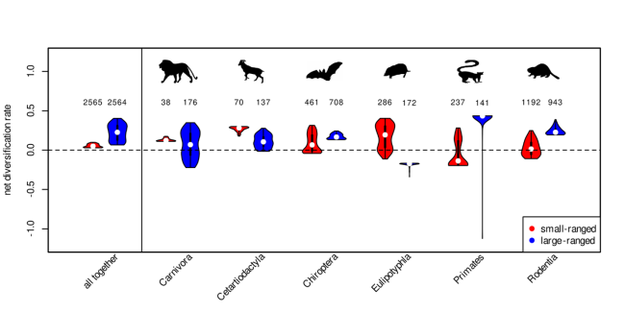Scientists' discovery of species diversity in Nature Communications
 Fig.1: The cape ground squirrel (Xerus inauris) has many closely related species, whereas platypus is an old and isolated evolutionary lineage.
Fig.1: The cape ground squirrel (Xerus inauris) has many closely related species, whereas platypus is an old and isolated evolutionary lineage.
“The problem with this Darwinian hypothesis is that it is difficult to test. When we look at phylogenetic trees showing the relatedness of species, we often find that species with small ranges have a number of many close relatives, which would suggest that these species are diversifying faster. But that doesn't necessarily have to be the case - in fact, it may also be species whose ancestors had larger ranges that broke up, giving rise to a number ofto a cluster of species with small ranges. Therefore, small areas of occurrence can either have a higher ability to create new species, or, on the contrary, they can be the result of the previous differentiation of species with larger ranges, about which we no longerdo not have direct information. To find out whether species with larger ranges diverge faster or more slowly, we need a different method than direct analysis of kinshipspecies relatedness," says Jan Smyčka from the Center for Theoretical Study of Charles University and the Academy of Sciences of the Czech Republic.
Jan Smyčka together with Anna Tószogyová and David Storch decided to investigate the issue of species diversification using the so-called SSE models (State-dependent Speciation-Extinction models). These are mathematical models of evolution, where individual evolutionary lineages can transition between different states (e.g. corresponding to different sizes of geographic ranges) with different probabilities, and diversify at different rates depending on the value of the given state. Then it is possible to calculate which parameters of the evolutionary process have the greatest probability by comparison with real data, i.e. with the shape of the phylogenetic tree and information on the range size of individual species (i.e. the tips of the tree). For example, it is possible to estimate how often does a species with a large range give rise to two daughter species with smalllarge ranges, and whether it is more common for a species with a large range to diversify into one species having large and another having small range.
 Fig. 2: Diversification rates (speciation minus extinction) predicted by the SSE model for species with large (blue) and small (red) ranges. On the left, rates for all mammals combined,on the right for individual mammalian orders. Numbers above the graphs indicate the numbers of species in each category.
Fig. 2: Diversification rates (speciation minus extinction) predicted by the SSE model for species with large (blue) and small (red) ranges. On the left, rates for all mammals combined,on the right for individual mammalian orders. Numbers above the graphs indicate the numbers of species in each category.
When the authors applied these models to data on the phylogeny and range sizes of all mammals, they found that species with large ranges did indeed diversify faster on average, as Darwin predicted (Fig. 2 left). At the same time, species with large ranges typically speciate in such a way that at least one of the daughter species has a small range. However, this does not apply to all mammalian orders – for example, in ungulates or bats, the relationship is reversed, and species with a small range often diversify faster there (Fig. 2 right). A detailed study of these exceptions has shown that it is practically always a situation where a certain lineage settled an isolated area with a number of internal geographical barriers, namely a group of islands or a mountain (Fig. 3). In these areas, thanks to a large number of geographical barriers, new species are quickly created, but for the same reason they have small ranges.
 Figure 3: Exceptional lineages in which species with small ranges diversify faster. Top, Indo-Pacific fruit bats (Pteropus), bottom, Central Asian goats (Capra). Colored dots indicate the observed states of the current species (large range in blue, small range in red) and the likely values of the states of their common ancestors, gray dots indicate the rate of diversification.
Figure 3: Exceptional lineages in which species with small ranges diversify faster. Top, Indo-Pacific fruit bats (Pteropus), bottom, Central Asian goats (Capra). Colored dots indicate the observed states of the current species (large range in blue, small range in red) and the likely values of the states of their common ancestors, gray dots indicate the rate of diversification.
These findings have interesting implications. It means that while Darwin's original idea was correct in principle, and species with large ranges generally diversify faster, specific geographic conditions can really shuffle with that. Species with a large range have a greater evolutionary potential and are therefore worth protecting, but geographical conditions are crucial and environments with many barriers, such as archipelagos or mountains, represent the cradles of the new species and therefore deserve special attention. The general ecological and evolutionary theory can therefore only be applied to a limited extent and it is necessary to take into account the local specifics of the areas where evolution takes place.
Smyčka, J., Toszogyova, A. & Storch, D. The relationship between geographic range size and rates of species diversification. Nat Commun 14, 5559 (2023).The relationship between geographic range size and rates of species diversification | Nature Communications
Document Actions